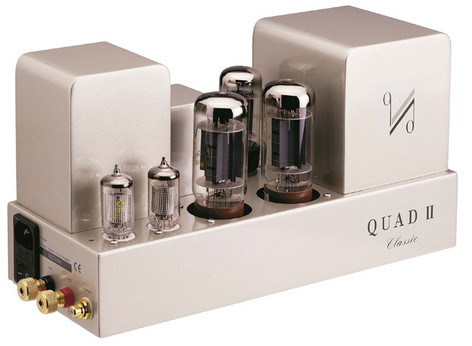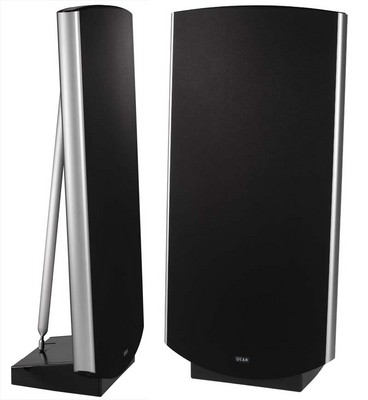
QUAD ESL-QXOT@
QUAD ESL-QXOT Electrostatic Loudspeaker
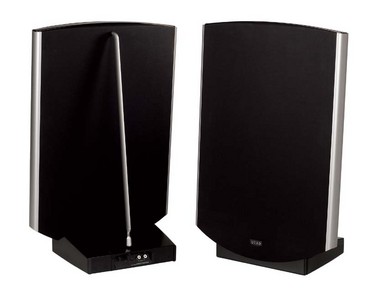
QUAD ESL-QWOT
QUAD ESL-QWOT Electrostatic Loudspeaker
The ESL-2805 is the smaller of the two models using six panels rather than
the 8 of the larger model. The inner two panels of the ESL-2805s construction,
again utilise the concentric anode rings for point source imaging, and the
outer rings are again linear in their response. Whilst absolute bass extension
and dynamic ability is less than itA?AfA?AA?AAa?ΚA!A?AΚA?AAa?ΚA?A?As
larger brother, the ESL-2805 offers a sublime performance.
The clarity of mid-range for which the QuadA?AfA?AA?AAa?ΚA!A?AΚA?AAa?ΚA?A?As
are most famed is fully in evidence, as is the sparkling detail and transparency
that has long been the hallmark of this series. Their response characteristics
are virtually identical and a base weight of 34.8kg together with the rigid bracing,
ensures they are suitably deep in bass and dynamic enough to fill all but the
largest of listening rooms. For the Quad aficionado without the need or desire
for the additional bass extension of the larger model this, the smaller of the
ESLs is still regarded as the pinnacle of electrostatic refinement.
Inside the II-forty Amplifier system@
The circuit used in the Quad II-forty power amplifiers is virtually identical to that used in the original Quad II. What has changed dramatically, is the standard of components used. We have scoured the globe for the very finest vacuum tubes, balanced and matched perfectly. The transformer is, in itself, a work of art. Everything is hard-wired and hand crafted with incredible precision.
We now use KT-88s, rather than the original KT66s in push-pull orientation for the output stage (for more power). The input valves are 6SH7s(military spec.) and the rectifier is a 5UG4.
The pre-amplifier supplied with the system is a completely new design. It uses a very special high-end military 6111 twin triode, which is so reliable and accurate, it has been hard-wired into the circuit.
All inputs are line-level. It uses relay signal switching to preserve signal integrity. This is one of the most neutral and transparent pre-amplifiers available today. It contains no tone controls, has no remote control. Quite simply, it adds nothing and takes nothing away from the signal.
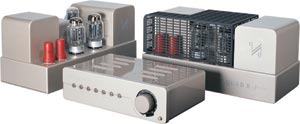
Quad II-forty Monobloc Power Amplifier@@@@@ @ |
|
| Specifications@ | |
| Valve complement | 2 x KT-88 |
| 2 x 6SH7 | |
| 1 x 5U4G | |
| Total Harmonic Distortion at 700 Hz | 0.3% at 40W |
| 0.03% at 1W | |
| Frequency Response | 10Hz to 30kHz (+0 / -0.5dB) |
| Damping Factor | 20 at 700Hz (8 ohm) |
| Hum and Noise | better than -80dB |
| Loudspeaker taps | 4 ohm and 8 ohm |
| Sensitivity | 1 V RMS |
| Power Consumption | 180W maximum
|
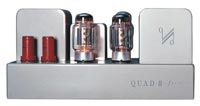
QC- twenty four Stereo PreAmplifier@@@@ @@ |
|
| Specifications@ | |
| Valve complement | 1 x 6111 twin triode |
| Total Harmonic Distortion at 1V RMS | <0.2%, 0.02% @ 1W |
| Frequency Response | 5Hz to 50kHz (+0 / -0.5dB) |
| Hum and Noise | better than -80dB |
| Line Stage Gain | 15dB |
| Recommended minimum load | 50k ohms |
| Inputs | 5 x line level |
2 x buffered tape loops
|
|

| 99 CD-P CD Player@ | ||
| Specifications | ||
| Maximum Line Output Level (RCA) | 2.4VRMS | |
| Maximum Line Output Level (Quad-Link) | 5.3VRMS - Balanced | |
| Frequency Response | 20Hz-20kHz (+0dB/-0.5dB) | |
| Total Harmonic Distortion | <0.002% at 1kHz | |
| Signal to Noise Ratio | >110dB, 24 bit | |
| >95dB, 16 bit | ||
| Crosstalk | <-100dB at 1kHz | |
| DA Converter | Max. resolution | 24bit |
| Max. sampling speed | 192kHz | |
| Upsampling | x2 | |
| Digital Audio Inputs | 3 x RCA Coax 75ohm, SPDIF | |
| 3 x Optical TosLink, SPDIF | ||
| Digital Audio Outputs | Optical TosLink, SPDIF | |
| Disc compatibility | CD-DA Conventional Audio CD | |
| CD-R Recordable CD (finalised and unfinalised) | ||
| CD-RW Rewritable CD (finalised and unfinalised) | ||
| Dimensions | 80mm x 321mm x 310mm | |
| Weight | 7.2kg net
|
|

| 99 Pre-Amplifier@ | ||
| Specifications | ||
| Aux. & Tape Inputs | ||
| Sensitivity | 100, 300 or 775mV | |
| Signal-to-Noise Ratio | >97dB (A) ref. 775mV | |
| Distortion | <0.002% | |
| Phono Inputs MM (MC) | ||
| Sensitivity | 1, 3 or 7.75mV (100, 300 or 775uV) | |
| Signal-to-Noise Ratio | 78dB (a) ref. 7.75mV (775uV) | |
| Distortion | <0.005% (<0.01%) | |
| Pre-Amp Output | ||
| Level | 775mV (3.3V max.) | |
| Source Impedance | 100 ohms | |
| AMPBUS Output | ||
| Level | 2V (8V max.) | |
| Source Impedance | 20 ohms | |
| Tape Output | ||
| Level | 100, 300 or 775mV (10V max.) | |
| Source Impedance | 330 ohms | |
| Frequency Response | ||
| All Inputs except MM/MC | 10Hz - 20kHz | +0dB/-0.3dB |
| 3Hz - 56kHz | +0dB/-3dB | |
| MM/MC Inputs | 20Hz - 20kHz | +/- 0.5dB |
| 7Hz - 53kHz | +0.5dB/-3dB | |
| Dimensions | 70mm x 321mm x 310mm
|
|

| 99 Stereo Power Amplifier | |
| Specifications | |
| Maximum Power Output | 90wRMS into 8ohms (0.5% THD) |
| 120wRMS into 4 ohms (0.5% THD) | |
| Maximum Output Current | 11 Amps peak each channel |
| Total Harmonic Distortion | <0.05% (70w into 8ohms) |
| Input Sensitivity (phono) | 775mV |
| Output Impedance | 1.5 uH in parallel with 0.05ohms |
| DC offset voltage | less than 10mV |
| Frequency Response | 3Hz to 50kHz +0dB/-3dB |
| Signal-to-Noise Ratio | 110dB (20Hz-20kHz) ref. 70w RMS |
| Dimensions | 70mm x 321mm x 310mm
|

| 909 Stereo Power Amplifier | |
| Specifications | |
| Maximum Power Output | 140wRMS into 8ohms (0.5% THD) |
| 250wRMS into 4 ohms (0.5% THD) | |
| Total Harmonic Distortion | <0.02% (100w into 8ohms) |
| Input Sensitivity (phono) | 775mV |
| Output Impedance | 1.5 uH in parallel with 0.05ohms |
| DC offset voltage | less than 10mV |
| Frequency Response | 13Hz to 40kHz +0dB/-1dB |
| Crosstalk at 1kHz | -90dB |
| Signal-to-Noise Ratio | >108dB (20Hz-20kHz) ref. 140w RMS |
| Dimensions | 140mm x 321mm x 240mm |
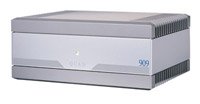
QUAD UK(pj@z[y[WΦΜN ipΆΜέj
Given the quite modest components of the day, he was able to engineer something which was quite literally greater than the sum of its parts. The Quad II-Classic has been recreated accurately with output valves and input valves the equivalent of those used in the original design. The same balancing act has been employed to ensure the same wealth of detail and gentle tone of the original. The output valves produce around 15watts per channel, operating in Class A which, although slight by modern standards, allows a gloriously sweet and refined sound with appropriately matched contemporary loudspeakers
